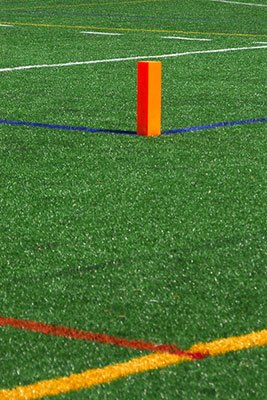Are you a lacrosse enthusiast looking to improve your game? If so, you must understand the rules of boundaries. Understanding when to stay in bounds and when to come off is essential for any player.
In this guide, we’ll break down the lacrosse boundary rules as well as offer some tips on how to become a better lacrosse player by paying attention to these guidelines. Keep reading for everything you need to know about playing on or near the sidelines!
More...
Take away key points:
Lacrosse restraining lines for possession of the ball
The US Lacrosse is full of rules for restraining lines on the outdoor lacrosse field. Each part of the field has its boundaries, and if the player crosses a specific restraining line, he will commit minor fouls or major fouls, based on the severity of the penalties.
Let's learn the lines and rules in lacrosse.
Lacrosse field areas

The lacrosse field is divided into three main parts: attacking area - critical scoring area, midfield area, and defensive area.
In men's lacrosse, three defensemen play in the defensive area, three midfielders play around the midfield line, and three offenders-attackers play in the attacking area. The midfielders can move through all three areas.
Women's lacrosse includes three defensemen in the defensive area, three midfielders around the midfield line, and four attackers in the offensive half. The goalies remain in the defensive areas near the crease line.
Basic boundary rules
We have included some of the most common rule violations. Read them thoroughly for a better understanding.
1. Turnovers
When the lacrosse ball goes out of the boundary line in lacrosse, it results in a space violation, as a minor foul. The referee will stop play and the opposing team will gain possession of the ball.
The game is also considered out of bounds when a player touches the restraining line with his feet. The quick restart works for the other team, and they will bring the ball back into the game to continue the game.
2. Backup for the player with the ball
When the ball crosses behind the restraining line following a shot, the possession is assigned to the team whose player was the closest to the ball during the time the ball crosses the line.
Often after a shot, players from opposing teams rush toward the boundary line to be closest to the ball and receive the ball possession.
3. Restraining line rules
The restraining line serves to determine that only a certain number of players are in the offensive half of the defensive half of the field at a given time. During the face-off or draw, all players aside from the center draw or face-off must stay behind the wing area line or behind the restraining line.
In men's lacrosse, six players from one team can cross the center line to enter the offensive half, and seven players (the goalie included) can cross the line to enter the defensive half of the field.
In the women's game, seven players from one team can cross the center line to enter the offensive half, and eight players (the goalie included) can cross the line to enter the defensive side of the field.

4. Clock rules
The restraining line also includes time clock rules. Once the defense wins the possession in their half, they will have twenty seconds to transition the possession past the midfield line.
In addition, they will have extra ten seconds to move the possession into the restraining box. To prevent the attack from a stall play, officials add the thirty-second shot clock to ensure the attack cannot leave the restraining box.
5. Substitution area
The player running off the field and preparing to be substituted must be within ten yards and moving toward the sideline before his teammate can leave the substitution box to replace him.
If a player leaves the box too early and enters the field, the referee will call upon the illegal substitution or offside, resulting in the delay of the game penalty.
6. Goal crease area rules - critical scoring area
A penalty for violating crease rules is the crease violation. A violation is a penalty for the infraction and illegal movement of an attack player in the goal circle and crease area.
In men's lacrosse, the crease violation occurs when an attacker touches or crosses the goal circle unless he was shooting and his body was moving away from the goal.
If a goalie fails to clear the ball from the ground within four seconds in men's and ten seconds in women's lacrosse, the crease violation will take place. However, the defenders are allowed to enter the crease to defend an offensive player.
Is stick-to-stick contact also part of these violations?
The stick-to-stick contact is not part of the boundary rules, as it's a personal foul, and it requires a stricter punishment if the referee determines the player's safety is jeopardized.
For instance, an offender uses the stick to hit another player's head. Players should use their stick skills only to play fair, retrieving a ground ball, or block a pass or shot.
Women's lacrosse boundary rules & violations
Women's lacrosse has minor and major fouls. When a minor penalty is committed anywhere on the lacrosse field, the offender must take four meters to whatever side she was guarding the player she fouled.
However, if a major obstruction occurs outside the 12-meter fan or 8-meter arc, the offender must remain four meters behind the player she impeded. Major obstructions are committed inside the eight-meter arc or twelve-meter fan, and the penalty shot is given to the non-offending team.
Below you can find some of the most common rule violations in the women's game. Let's learn them.
- Shooting space violation: Occurs when a defender disrupts the free space to goal inside the attacking area - critical scoring area. Free space to goal is determined by an imaginary path from the ball to the outside of the goal circle.
- Indirect free position: A minor foul when the player assigned the possession might not shoot immediately. She can wait to shoot or pass the possession to a team member until a defender checks her stick.
- Deputy: A player entering the goal circle when the goalkeeper is out of the goal circle and her team has the ball.
- Center circle: Two players set up to draw the ball and start the game.
- Penalty lane: An imaginary goal path, determined by two parallel lines extending from each goal side to four meters on either side of the player suffering the foul.
FAQs
What are the boundaries in lacrosse?
The boundaries are marked with white lines, and the center line is additionally highlighted across the center of the field. Sidelines are long boundary lines during the long sides of the field, and boundary lines at each end are called end lines.

What are the out-of-bounds rules in lacrosse?
The out-of-bounds rules refer to a situation when the player has the ball or the ball goes out of bounds, and the opponent gets the possession. But, when the ball goes out of bounds after a pointless shot, the player nearest to the ball will get the possession.
What happens if the ball goes out of bounds during a goal shot in lacrosse?
The player that is nearest to the ball after the shot will receive the possession.
What are the 6 types of boundaries?
The six types of boundaries include: end line, sideline, midfield line, restraining line, center line, crease line.
Can you shoot from anywhere in lacrosse?
Players can score from anywhere on the field, except from the opponent team's crease area.
Summary
Respecting all the lines and staying in your designated area during a game of lacrosse is crucial if you want to maintain control over the ball and play to win.
With lacrosse boundary rules in place, changing possession can occur if one team steps out of bounds or into the wrong zone, so it's important to be aware of your surroundings at all times.
Staying within the lines may seem like a simple task, but it can make all the difference in whether or not your team scores goals and comes out on top.
